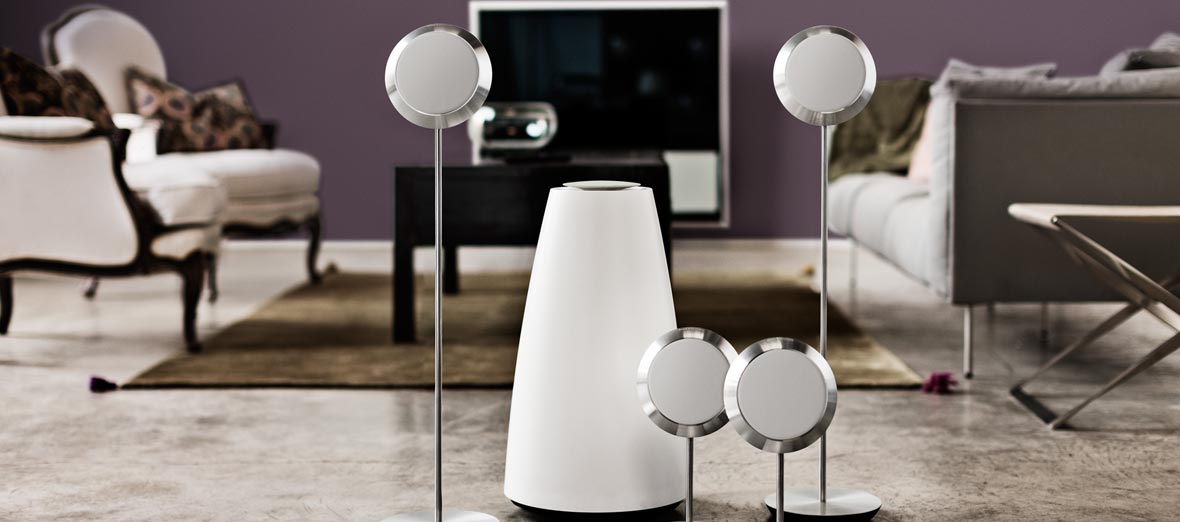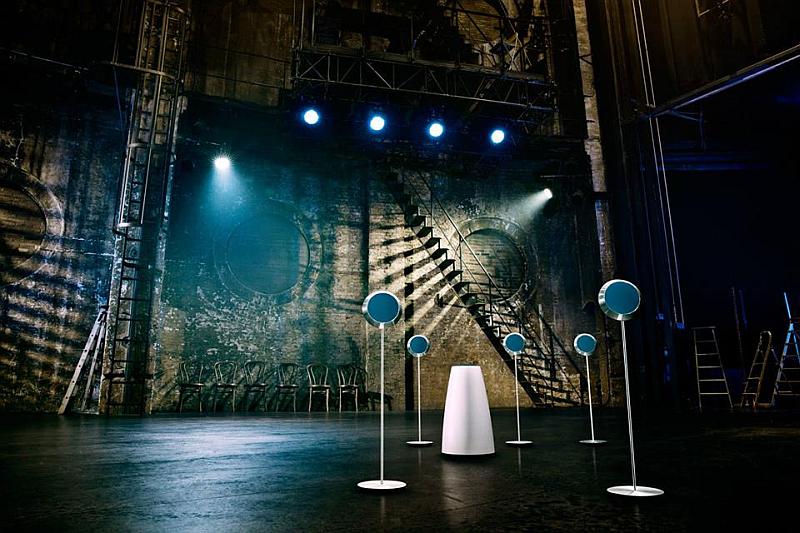
A few weeks ago Decoist was invited to London to see Bang & Olufsen‘s latest product, the BeoLab 14. I attended the official unveiling presentation which took place at the glamorous Cafe Royal Hotel on Regent Street — a rather stunning place that promises to redefine the concept of the luxury hotel for the sophisticated, design literate travelers — and must say that I was quite impressed. Not only did I get to listen to a remarkable new sound system, I was quite amazed by its stylish appearance.
The system comes with a petite cylindrical subwoofer which hides a 280-watt amp and connections for up to five individually powered (140 watts) and equalized 2.5-inch satellite speakers, each with its own amplifier. And while this sounds impressive on its own, the real charmer of the BeoLab 14 is the clean and minimalist design with Scandinavian influences that will make it stand out in any room. But Bang & Olufsen fought a hard battle in order to get the best of design and audio performance, at the same time.
To convince ourselves they made no compromise, we got to talk with designer Torsten Valeur, the person who gave birth to the BeoLab 14.
Your inspiration was to give the consumer a “surprisingly big sound experience” while providing a visually stimulating look. What specifically inspired the unique look of your subwoofer?
Vases on the floor were inspiring me. Vases are common to most interiors, can be placed easily anywhere on the floor and fit in easily. I wanted to achieve the same with the subwoofer. Of course I could not imitate a vase, that would be artificial, but the vase was giving me the understanding of how the solution could be. The top with the bass reflection port however was inspired by the brass instruments with dampers you find in bug jazz orchestras.

The design of the “lollipop-looking” speakers is definitely eye candy. What muse awakened this particular design?
I was holding the speaker driver in my hand and wondering how to wrap it making it appear as small as possible. Pure logic was guiding me letting one form experiment lead to the next. In this process images pops up, like dress room mirrors, classic standing microphones or the “fei Jie” Chinese circus artists spinning plates, and that has inspired me.
Your video says the speaker system took 500 hours of design and 2000 hours of sound engineering. What were your biggest hurdles overcome in each of these areas?
To get the right idea, to find the true identity of the project is always the challenging part. I have to find the unique reason for the object to exist.
It was also challenging to get the subwoofer as slim and still not compromising the performance. And to get the details of the speakers and subwoofer so clean that there is no unwanted mechanical details.
The speakers are made of Aluminum. Other than the fancy look is there another reason why you decided not to go for high quality wood or other materials?
Bang & Olufsen are world champions when it comes to aluminium, so it is always a very relevant material to consider, and for a loudspeaker even more, since the material is also optimal when it comes to the acoustic performance, being very hard and with no vibrations. You can also craft aluminium incredible precise and solid, yet let it appear so light visually.
Wood could also be an option, but for this concept I wanted the speakers to stand out when in focus, but blend in when not. That metal in particular is optimal when you are looking for that, since the aluminium takes up the colours of the surroundings.

You have said that the performance goal is to meet or exceed the sound reproduction of competing companies and products. In your opinion, have you surpassed them in performance?
I personally think that we have optimized the sound in all ways. Whether we have surpassed the competitors, I am not the one to judge – that should be someone specialized within that field. But being able to get that kind of sound quality out of a cabinet of the size of the BeoLab 14 satellites definitely makes us stand out in the crowd.
The design, the craftsmanship, the specialness of the sound; you might need to compromise a little bit. How did you manage not to?
There will always be some compromises along the way, but the way I work with Bang & Olufsen where I also get to discuss my design with the specialist from the aluminium factory, the sound specialist, etc. we can usually solve these in the most optimal way.

Some may not look at the BeoLab 14 as a sound system, but more like a design statement. It looks great in a contemporary setting, I give you that. But then the music starts playing, and we are astounded. Is this something you planned from the very beginning?
Yes indeed and that is why I use all my “design tricks” to make speakers appear as small as possible.
The surprise of the sound paired with the relatively small cabinet is in some way part of the overall design concept. I know that Bang & Olufsen is capable of producing impressive sound from small devices so that is a form of magic element that can be thought into the product. As you also write it is a surprising and magical experience when sound appears and that experience for the user to have is also one of my goals with my designs (and a constant challenge to Bang & Olufsen acoustical specialists J).

We think that there’s a thin line between decorating your home and installing the right sound system. Everything needs to be taken care of with utmost attention to even the smallest details. What should we consider?
Get the best sound you can without disturbing your decor. The system should be very flexible and be able to fit in everywhere and not force you to change your decor. Technology should obey you, not the opposite, right.
Be sure that all issues have been dealt with, from invisible mounting screws, hidden wires to the overall flexibility.
Speakers should, as all objects and furniture for your interior, easily melt into your decor in an unobtrusive way. At the same time it must have a unique identity and personal beauty in itself, not being indifferent.

In the end, mind telling us what can we look forward to seeing from you in the future for our homes and enjoyment?
I am almost finishing some new products that will appear in the near future. There is one very small object and some is really big. I am looking forward to present all, I feel the products will surprise positively. I am afraid that is all I can tell.












